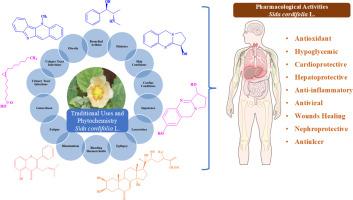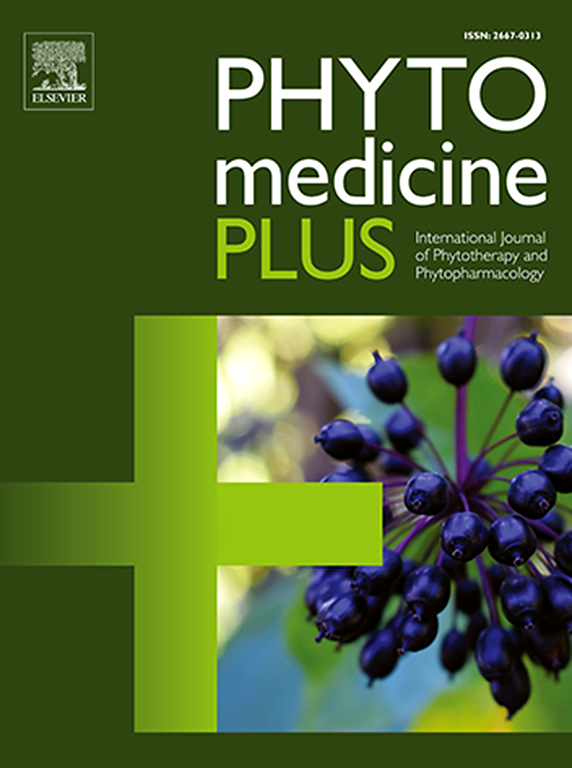A comprehensive overview of phytochemical composition and therapeutic applications of Sida cordifolia L․
Q3 Pharmacology, Toxicology and Pharmaceutics
引用次数: 0
Abstract
Introduction
Sida cordifolia L., commonly known as "Bala" or "Country Mallow," is a well-known herb in Ayurvedic and other traditional medicine systems, widely distributed in tropical regions such as India, Brazil, Bangladesh, and Sri Lanka. Traditionally, indigenous communities have used various parts of the plant to manage health conditions like asthma, bronchial disorders, skin diseases, urinary tract infections, dysentery, fever, and as a general tonic. Its use is also documented in Siddha, Unani, and folk medicine for treating inflammation, pain, and as a stimulant.
Methods
This review synthesizes data from ethnobotanical surveys, phytochemical analyses, and pharmacological studies to provide a comprehensive overview of Sida cordifolia. Literature was sourced from Scopus, PubMed, and Google Scholar databases to examine the plant’s distribution, morphological features, economic aspects, phytochemistry, traditional uses, common extraction techniques, pharmacological activities, and clinical studies.
Results
Phytochemical studies have identified key bioactive compounds in Sida cordifolia, including alkaloids like ephedrine, pseudoephedrine, vasicinone, and vasicinol, along with flavonoids, phytosterols (β-sitosterol, stigmasterol), and fatty acids (sterculic, malvalic, coronaric acids) distributed throughout the roots, seeds, and aerial parts. Modern pharmacological research supports its traditional uses, demonstrating anti-inflammatory, analgesic, antidiabetic, hepatoprotective, nephroprotective, anticancer, and antioxidant activities. However, due to the presence of ephedrine, the plant may cause stimulant-related side effects, resulting in regulatory restrictions in some countries.
Conclusion
Sida cordifolia L. is a versatile medicinal plant with a longstanding history in traditional medicine for treating a wide range of ailments, particularly respiratory and inflammatory disorders. Its rich phytochemical profile underpins diverse pharmacological activities, supporting both traditional uses and modern therapeutic research.

全面概述了紫堇的植物化学成分和治疗应用
简介sida cordifolia L.,俗称“Bala”或“Country Mallow”,是阿育吠陀和其他传统医学体系中著名的草药,广泛分布在印度、巴西、孟加拉国和斯里兰卡等热带地区。传统上,土著社区使用这种植物的不同部分来治疗哮喘、支气管疾病、皮肤病、尿路感染、痢疾、发烧等健康状况,并将其作为一般补品。在Siddha, Unani和民间医学中也记载了它的使用,用于治疗炎症,疼痛和兴奋剂。方法从民族植物学调查、植物化学分析和药理研究等方面对菖蒲属植物进行综述。文献来源于Scopus、PubMed和谷歌Scholar数据库,研究了该植物的分布、形态特征、经济方面、植物化学、传统用途、常用提取技术、药理活性和临床研究。结果通过植物化学研究,鉴定出了菖蒲中主要的生物活性成分,包括麻黄碱、伪麻黄碱、水杨桃苷酮、水杨桃醇等生物碱,以及分布在菖蒲根、种子和地上部位的黄酮类化合物、植物甾醇(β-谷甾醇、豆甾醇)和脂肪酸(甾酸、丙酸、冠酸)。现代药理学研究支持其传统用途,证明其具有抗炎、镇痛、抗糖尿病、保肝、保肾、抗癌和抗氧化活性。然而,由于麻黄碱的存在,该植物可能引起与兴奋剂有关的副作用,导致一些国家的监管限制。结论堇青花是一种用途广泛的药用植物,在传统医学中具有悠久的历史,用于治疗多种疾病,特别是呼吸道和炎症性疾病。其丰富的植物化学特征支撑着多种药理活动,支持传统用途和现代治疗研究。
本文章由计算机程序翻译,如有差异,请以英文原文为准。
求助全文
约1分钟内获得全文
求助全文
来源期刊

Phytomedicine Plus
Medicine-Complementary and Alternative Medicine
CiteScore
3.70
自引率
0.00%
发文量
178
审稿时长
81 days
期刊介绍:
 求助内容:
求助内容: 应助结果提醒方式:
应助结果提醒方式:


